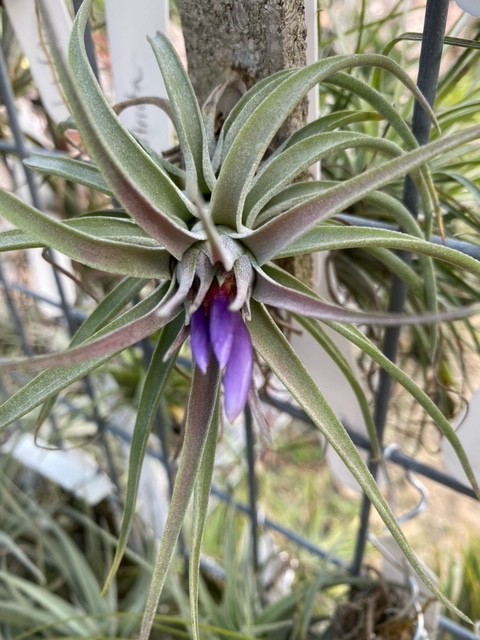

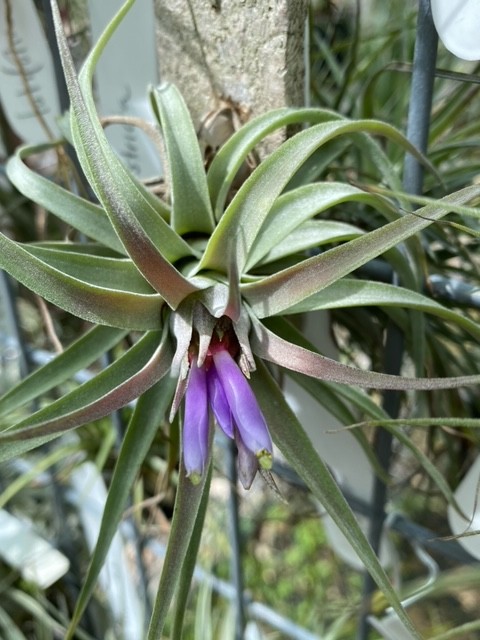
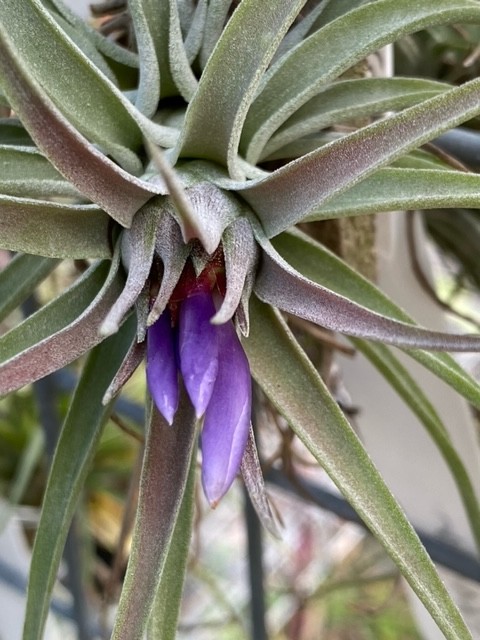
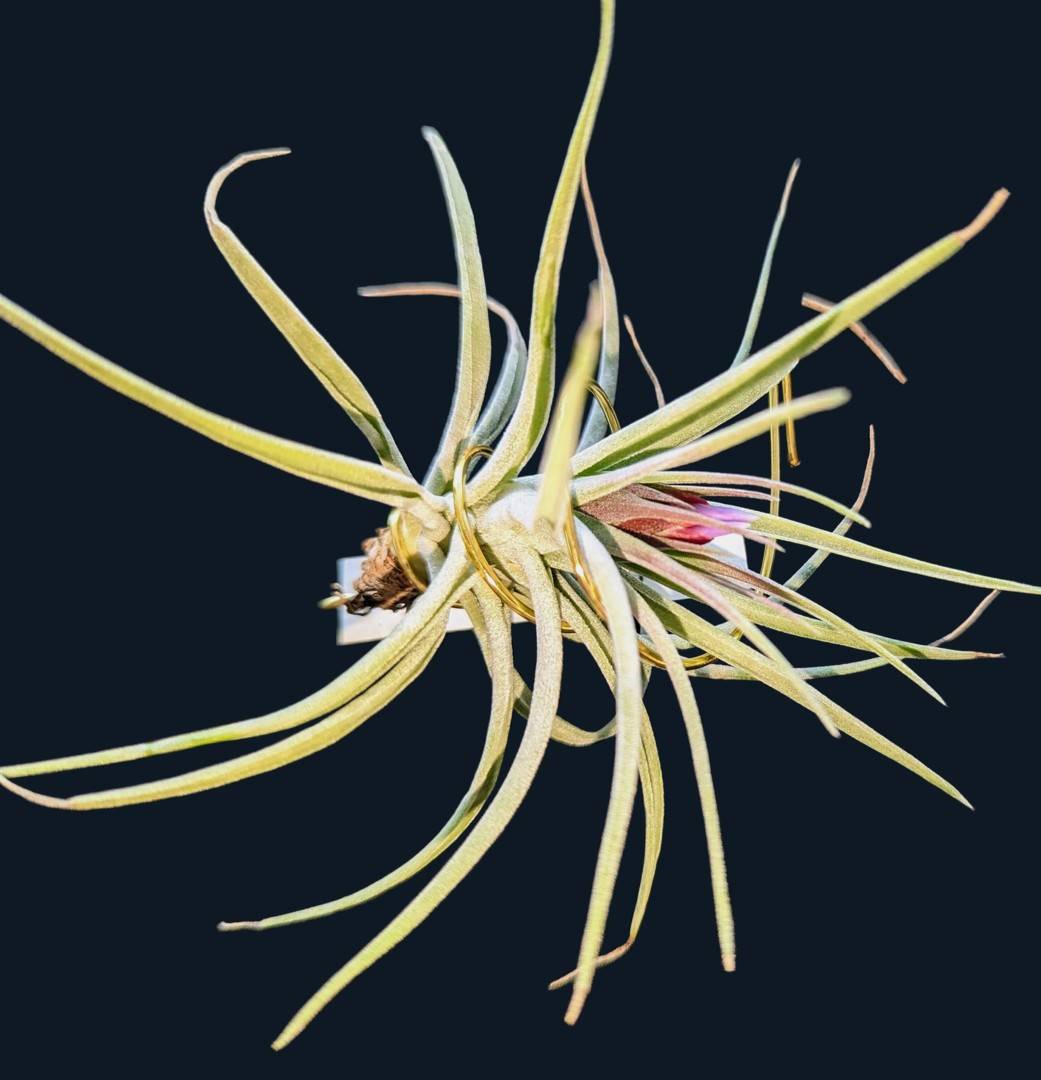
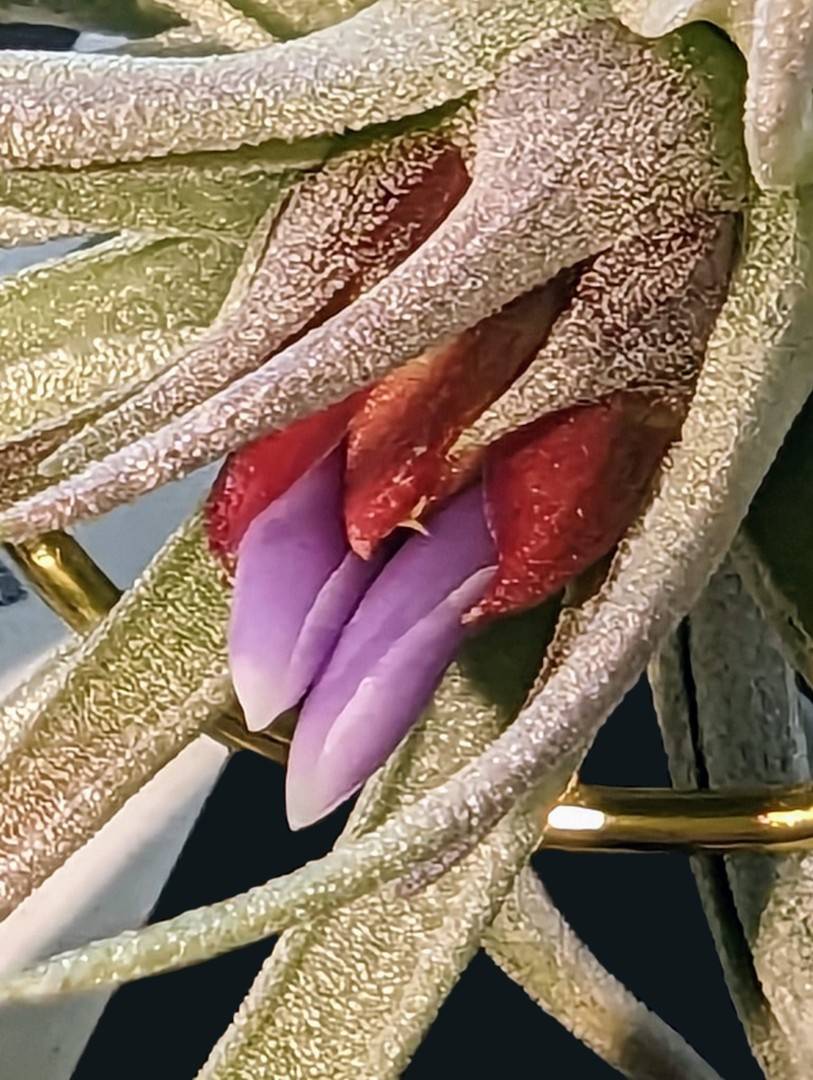
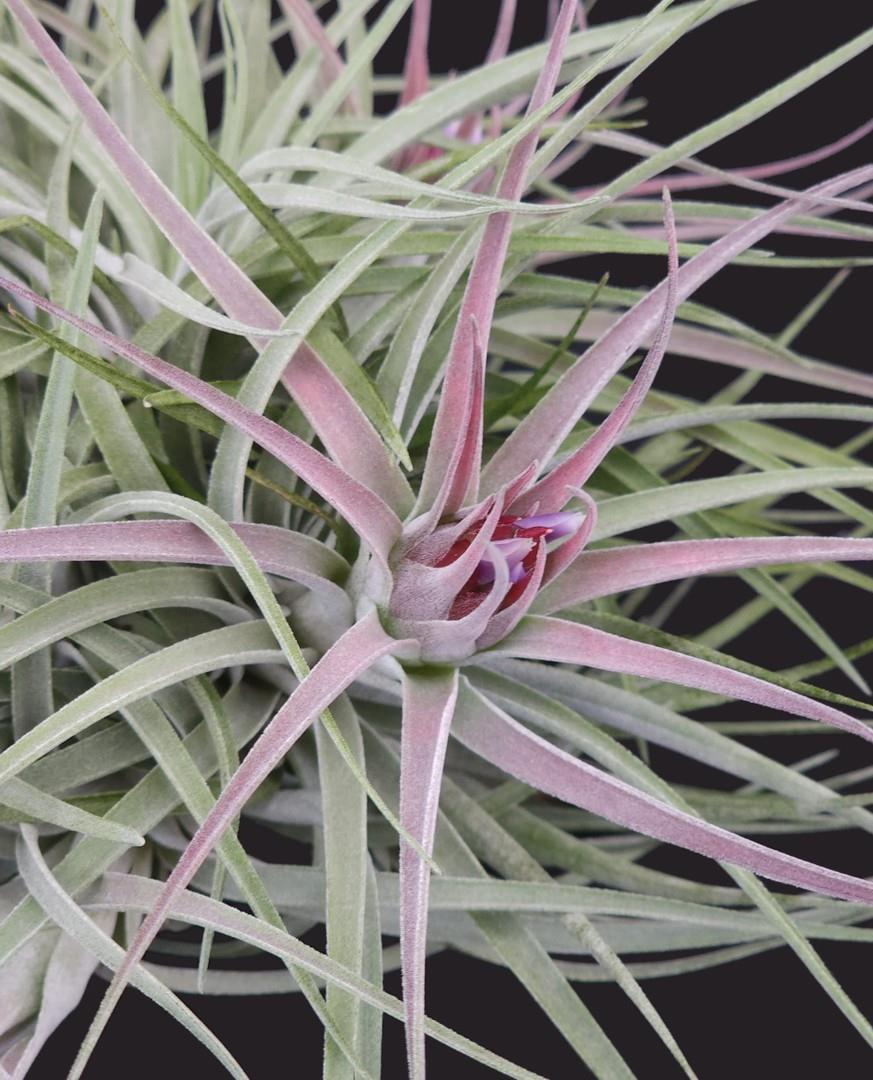
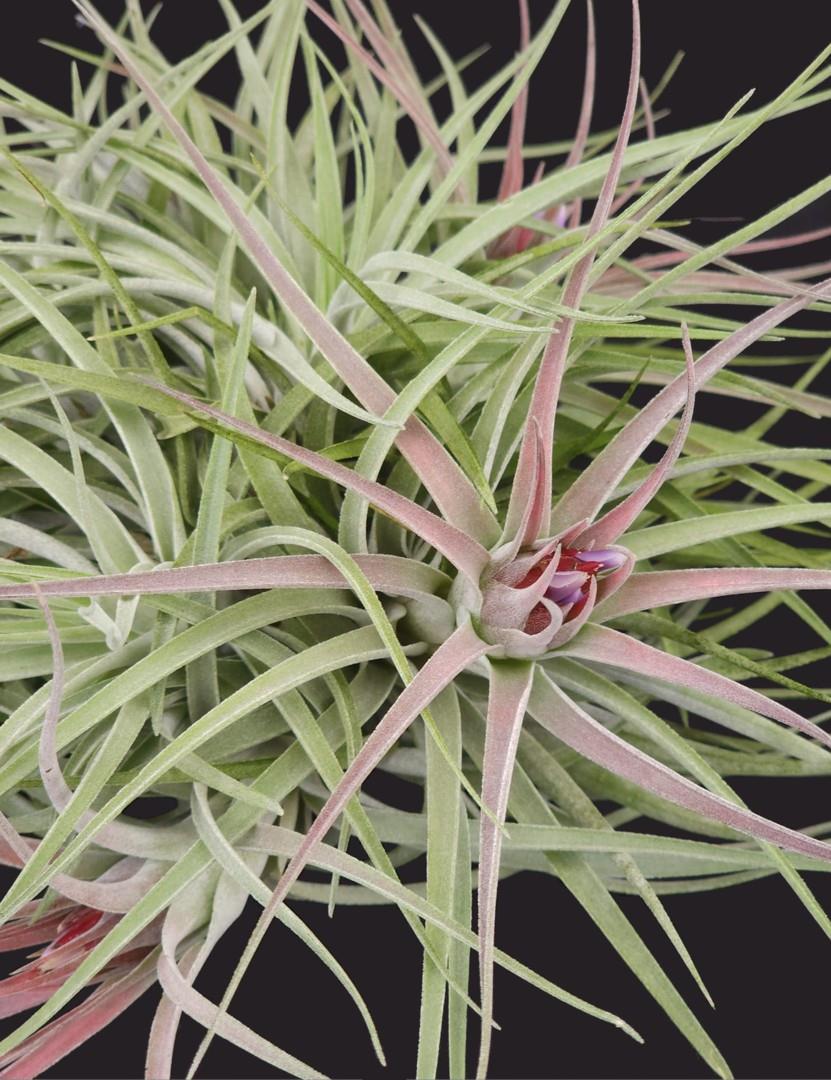
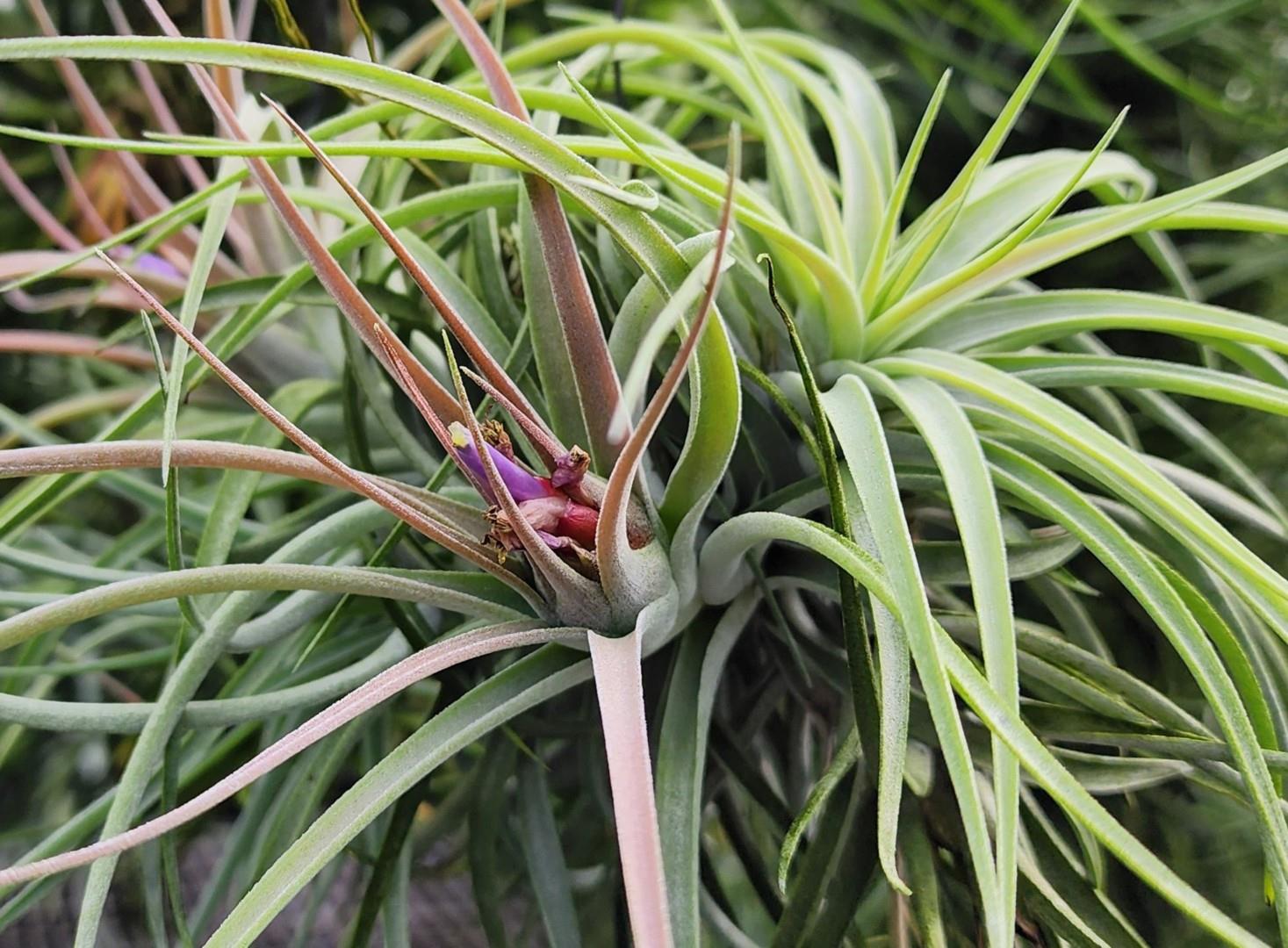
Pflanze stammlos, einzeln wachsend, epiphytisch, Bluhend bis 10cm hoch mit eingesenkter Infloreszenz. Blatter zahlreich, eine auf recht-ausge¬breitete Rosette von 15cm im Ø bildend (Abb. 25). Scheiden der ausseren Rosettenblatter nicht deutlich abgesetzt, weiss, zerstreut lepidot, rundlich, 5 x 5mm; die der inneren, kurzeren Rosettenblatter deutlich abgesetzt, loffelformig, beiderseits dichter beschuppt. Spreiten schmal-dreieckig, zugespitzt, involut, 7-5cm lang, sich zum Zentrum der Rosette verkurzend, oberhalb der Scheide ca. 1cm breit, weich, beiderseits dicht weis lepidot. Schuppen schwach exzentrisch. Schaft fehlend oder bis 0,5cm lang (Abb. 23 a, rechts). Schaftblatter fehlend. Inf1oreszenz kurz-zapfenformig, einfach, bis 3cm lang, 1,2cm dick, in die Rosette eingesenkt (Abb. 23 a), mit 3-4, etwas gekrummten, spiralig angeordneten Bluten. FloraleBrakteen rundlich-oval, zugespitzt, ± 2cm lang, 1,5cm breit, beiderseits lepidot (aussen starker, Abb. 26a, rechts), an der Spitze braunrot, gegen die Basis weisslich, ecarinat, langer als die Sepalen. Diese 15-16mm lang, 5mm breit, stumpf, kahl, membranos, ecarinat, bis zum Grunde frei. Petalen ± 4cm lang, zu einer gekrummten Rohre zusammenneigend, an der Spitze kurz zuruckgebogen, blass-violett, zur Basis hin weiss. Staubbeutel tief in der Rohre eingeschlossen; Filamente am Grund wellig verbogen. Griffel und die grunen Narben so lang wie die Petalen.
Habitat: Honduras; bei Gracias und Catacamas bei Juticalpa, epiphytisch auf Kaffee- und Mahagoni-Baumen, in ca. 1200m Hohe wachsend, leg. E. Kamm, Honduras.
Holotypus : B. G. H. 39283, Herb. Inst. System. Bot. Heidelberg (HEID).
T. kammii hat eine gewisse Ahnlichkeit mit einer sehr grossen, von Mexiko bis Nicaragua verbreiteten T. ionantha Planch., doch mussen bei dieser die Blattschuppen exzentrisch, die Scheiden elliptisch sein und sich deutlich von der Spreite absetzen; ferner sind die veilchenblau-violetten Petalen weit von den Filamenten und dem Griffel uberragt. Der Bestimmungsschlussel VIII von L. B. SMITH fuhrt zu der nur in Brasilien beheimateten Tillandsia rosea Lindl. (s. Abb. in Curtis Botanical Magazine, Vol. LXXXVII, 1861, Taf. 5246), doch sind bei dieser die Sepalen an der Basis verwachsen (nach der Originaldiagnose), die Bluten reinweiss und besitzen breite, spathulate, zuruckgebogene Petalen, wahrend sie bei T. kammii aufrecht und von blassvioletter Farbe sind; zudem sind die floralen Brakteen nicht rosafarbig, sondern braunrot. Nach L. B. SMITH ist T. rosea bisher nur aus der Umgebung von Rio de Janeiro bekannt.
Nach E. Kamm (schriftl. Mitteilung), nach dem these schone Klein-Tillandsie benannt wurde, ist die Pflanze selten und bisher nur von 2 Standorten bekannt, die ca. 200km voneinander entfernt liegen. Der eine Fundort ist ein Berg bei Gracias, der andere eine Kaffeepflanzung bei Catacamas, 40 km von Juticalpa entfernt. Sie wachst auf Kaffee- und Mahagonibaumen in einem relativ feuchten Klima, in Gesellschaft von T. schiedeana, T. valenzuelana, T. chaetophylla, T. filifolia, sowie Orchideen wie Gongora, Cattleya skinneri, Ornithocephalus-Arten u. a., in ca. 1200m Hohe (E. Kamm).
Auch aus arealgeographischen Grunden kann T. kammii von T. rosea abgetrennt und als eigene Art aufgefagt werden.
translated by Derek Butcher
Plant stemless, growing singularly, epiphytic, flowering to 10cm high, with a sunken inflorescence, leaves numerous, making an erect broad rosette, 15cm diam.
Leaf sheath on the outside of the rosette indistinct, white, scattered lepidote, roundish, 5 x 5mm, on the inside of the rosette, distinct, spoon shaped, both sides densely scaled.
Leaf blade narrow triangular, acuminate, rolled inwards, 5-7cm long, with the ones in the centre of the rosette shorter, 1cm wide next to sheath, soft, both sides dense white lepidote, scales weakly eccentric.
Scape missing or to 0.5cm long.
Scape bracts missing.
Inflorescence short cone shaped, simple, to 3cm long, 1.2cm thick, sunken in rosette, with 3–4 bent, spirally arranged flowers.
Flower bracts roundish oval, acuminate, ca. 2cm long, 1.5cm wide, both sides lepidote, the tip brownish red, the bottom part whitish, not keeled, longer than the sepals.
Sepals 15–16mm long, 5mm wide, blunt, glabrous, membranous, not keeled, free.
Petal ca. 4cm long, bent together in a tube, the tip short reflexed, pale violet, at the base white.
Stamens deeply enclosed in the tube, Filament bent rippled, Style and green lobes as long as the petals.
Type locality epiphytic on Coffee and Mahogany trees, near Gracias and Catamacas, near Juticalpa, ca. 1200m, Honduras.
Holotype E Kamm s.n. BGH 39 283 HEID
Differs from T. ionantha in
1. Leaf scales eccentric
2. Leaf sheath elliptic and similar to the blade.
3. Petals violet to blue violet.
4. Filaments wide.
5. Style exceeding the flower tube. NOTE both stamens and style can exceed the tube – See Selbyana vol. 15 p 114 1994
The Key number VIII of L. B. Smith leads to the Brazilian Tillandsia rosea Lindl. (see. Fig. in Curtis Botanical Magazine, Vol. LXXXVII, 1861, Taf. 5246), however the sepals are connate from the base (from the original diagnosis) the flowers pure white and with wide, spathulate, bent back petals, compared to T. kammii which are erect and pale violet colour and moreover, the floral bracts are not pink coloured but brownish red. According to L. B. Smith, T. rosea until now is only known from the area around Rio de Janeiro.
According to E. Kamm (personal communication), after whom this beautiful small Tillandsia was named, the plant is known only rarely from 2 areas and until now located, about 200 km apart. One is located on a mountain near Gracias, the other a coffee plantation near Catacamas, 40 km from Juticalpa. They grow on coffee and Mahogany trees in a relatively moist climate, in association with T. schiedeana, T. valenzuelana, T. chaetophylla, T. filifolia, as well as orchids like Gongora, Cattleya skinneri, Ornithocephalus spp and at about 1200 m high (E. Kamm).
T. kammii can therefore be separated geographically from T. rosea and becomes a species in its own right.